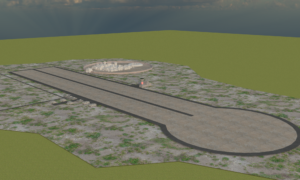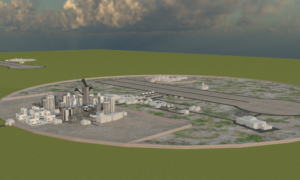Traveller Starport Classes
Way back when, there was an article about Starports in Traveller titled „Happy Landings“ by Thomas M. Price, published in White Dwarf magazine. It featured quite a few nice details about the layout of typical starports and also set the perspective of scale to another magnitude. A few days ago, I decided to create these starport types in Blender for potential future use in a 3D animation or just for reference.
Class E Starport
I started with the most simple installation, the Class E starport. This one comes in two variants. One with and one without an adjacent Scout Base. The first and second preview renders show both versions. You can see the circular shape of the scout base in the distance in the second picture.
Class D Starport
Then, based on the models created for the Class E, I started assembling a Class D starport, which also adds a startown to the concept. There also is a scout base shown in the distance. The whole port including it’s startown is circumfenced, as both – starport and startown – are under imperial jurisdiction and thus extrateritorial land on any planet. The port itself is also separated from the startown, to prevent civilians and drunken sailors alike roaming the installation. Being somewhat larger, the Class D port also features more Parking Bays.
Class C Starport
Based on that Class D starport mock-up, the Class C was created, adding more parking bays and pads, as well as a larger startown.
Class B Starport
Again based on the previous effort, this installation already shows size. Featuring two Landing Fields, connected by expansive Taxiways, that also lead to as many as 20 Parking Bays – not counting the Scout Base shown in the distance. The Startown again grew to about twice the size of the next lower Starport Class and the Support installations between the Landing Fields boast numerous Repair Hangars, Warehouses and Storage Facilities. The Size of the circumfenced area is aproximately 6 by 11 kilometres (for comparison: the runway portion of the landing field is aproximately 1 kilometre wide, with a total length of 5 kilometres (including the landing pad on one end).
If time permits me to do so, I will try to assemble a Class A starport next week. More renders will follow, as I plan to improve the materials and texturing. Also in this process I will try to define individual components to be reused without the need of individual editing. I hope to be able to create various starport layouts using these common components later.
Class A Starport
This time the Class A Starport differs slightly from the „Happy Landings“ Article, featuring more Parking Bays and an enclosed Navy Base. The image shows an Installation capable of servicing close to 500 smaller starships (up to 1000 tons) in its 71 parking bays plus a few hundred on the three landing fields.
ToDo
I plan to refine the materials an texture details. The landing field an Runways are to get some basic markings showing the runway and parallel taxiways, as well as the landing pad and the parking positions on the field. The scale of most of the hangars is off. These need to be scaled upwareds by a factor of 2.5 to 5 depending on the model used. The other models are all in the same scale as my Traveller starships.
The Class A Starport devellopment is currently on hold. I will first split the starports into individual files (they are all in the same file currently), to bring down the polycount, as the Class A Starport boasts as many as 60+ Landing Bays, three Landing fields (one being a Navy Base), all the associated support infrastructure and a Startown even larger than adjacent to the Class B Starport.
Textures are either procedural, or based on textures from maxTextures. Except for a few buildings from „Utopia City Blocks“ (by Stonemason). Parts of the Startown are made with Scene City (though some changes were necessary to get the total count of tris from more than 75 million down to something manageable by my computer).
I stumbled over the „Happy Landings“ Article while cruising the web on my regular sites. The „Atomic Rockets“ section of Project Rho featured the Maps used to assemble the models.





